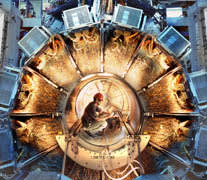With the electron and the muon neutrinos having been discovered, it seemed that the entirety of the neutrino could be grouped neatly into one or the other:
The fundamental constituents of matter could logically be grouped into families each containing two quarks and two leptons (u, d, e, nu_e, and c, s, mu, nu_mu). Ordinary matter is all composed of particles from the first family, the proton (uud) and neutron (udd) are composites made of quarks and the electron is the lightest fundamental charged particle, hence the name “lepton”, which originally meant “light particle” but later came to mean more generally a fundamental particle that does not participate in strong interaction processes. (The generic term for particles that do have strong interactions is hadrons, and all hadrons are, like the proton and neutron, composed of quarks.)
The particles of the second family are a repeat of the pattern of the first in every respect, except that they are more massive, and hence unstable. While there was no explanation for the existence of repeating families of fundamental constituents, the new arrangement made possible by the discovery of the charmed quark seemed more complete and symmetrical than that which had existed before. Since noone understood why there were two families, some speculations that there might even be more arose, but few scientists took them very seriously.

However, in 1975, Professor Perl, working with data from the MARK I collaboration on the SPEAR storage ring at Stanford Linear Accelerator Center (SLAC), announced evidence for the production of events containing both electrons and muons. These events signaled the production of a new heavy lepton that could decay to produce either electrons or muons, along with associated neutrinos. The first discussions of these results occurred at conferences in 1975 and the first paper appeared in Physical Review Letters in 1975. More data from the SPEAR storage ring and from the DORIS storage ring at the Deutsches Elektronen Synchrotron (DESY), located near Hamburg in Germany, in the period from 1975-1978 confirmed the discovery and the interpretation of the muon-electron production process as arising from a new heavy lepton, the tau. According to the pattern of the first two generations, such a particle will also have an associated neutrino type, which will be produced whenever it decays. All the observed tau processes are consistent with this interpretation.
The discovery of the tau came as a complete surprise to the physics community and signaled, if one was to believe in the family idea, the discovery of a third family of fundamental constituents that had to be accompanied by the appropriate quarks. Lederman and collaborators at the Fermi National Accelerator Laboratory (FNAL) found evidence for the bottom quark (the charge -1/3 member of the family) in 1976. Evidence for the existence of the much more massive top quark has come from FNAL in the last year.
Helen Quinn, Burton Richter